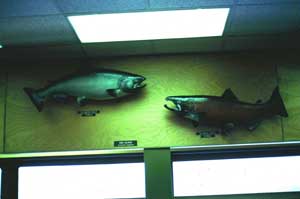|
|
 3 semelparous pred. satiation DHJanzen100394.jpg high resolution
|
|
| Salmon offer perhaps the most widely known example of semelparous predator satiation. Salmon grow for 3-6 years, first in the river of their birth and then in the sea, and then return to spawn in the headwaters of the river, and die. Because this is done synchronously within the year (and to some degree among years), the headwaters contain enormous numbers of (easily caught) spawning salmon, and then contain enormous numbers of (easily caught) salmon eggs and young fish, but (at least when wild communities were relatively intact) there were vastly more than all the predators - from huge bears to tiny insects - could possibly eat in the short time of salmon adult and offspring availability. Again, very strong selection against individuals out of phase with the great mass of fish. But, do not lose sight of the question of why semelparous rather than iteroparous (as are most fish)? In other words, why does an adult salmon not reproduce a third as much each of three years, rather than nothing for a number of years, and then a massive burst of reproduction in one year? Revisit this question after understanding the bamboo story below. | ||
back to lecture slides
or skip to: